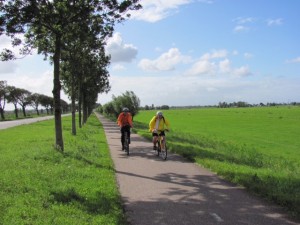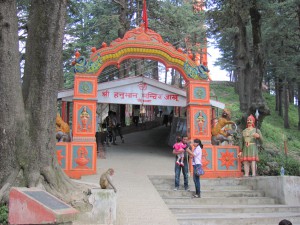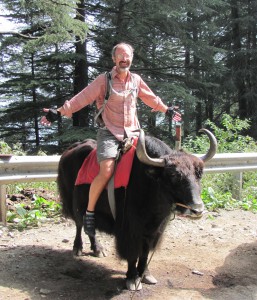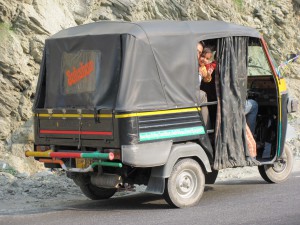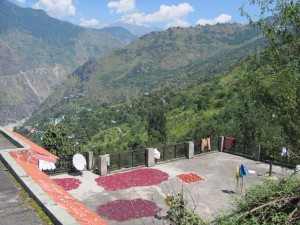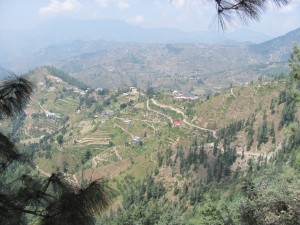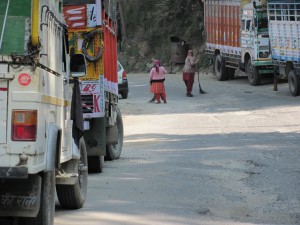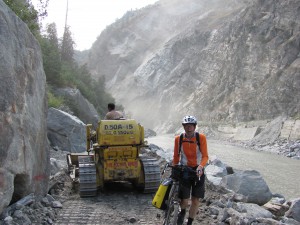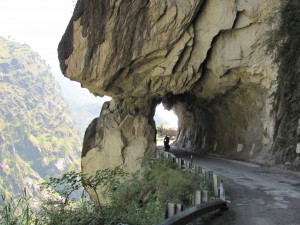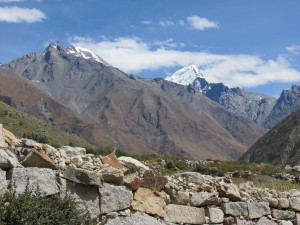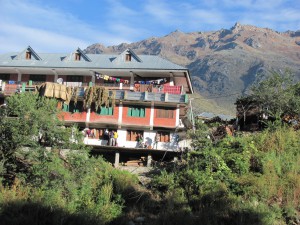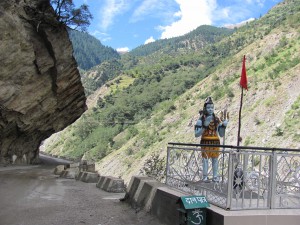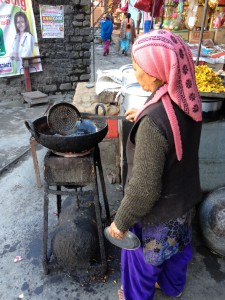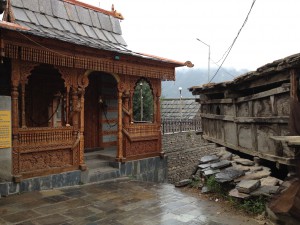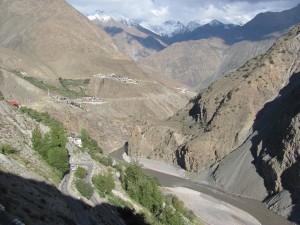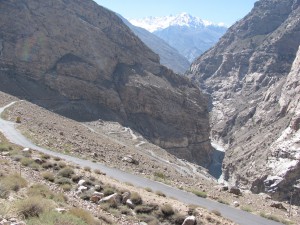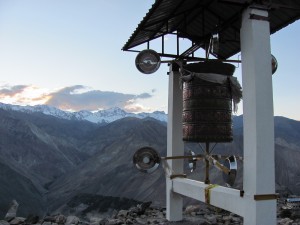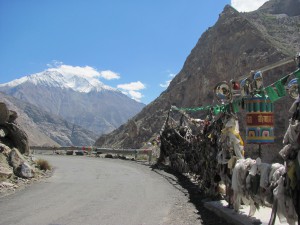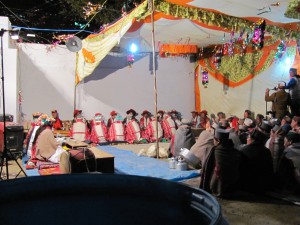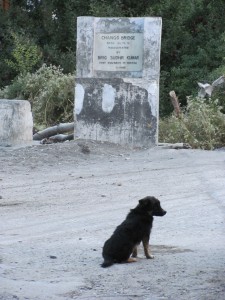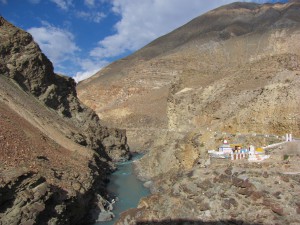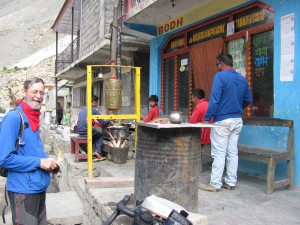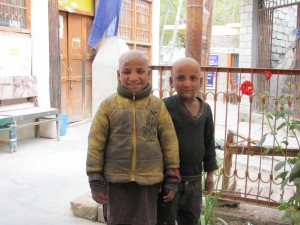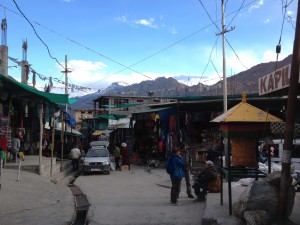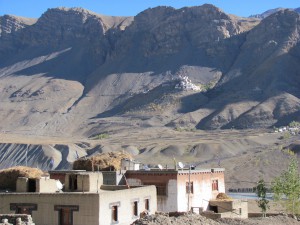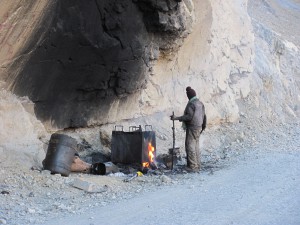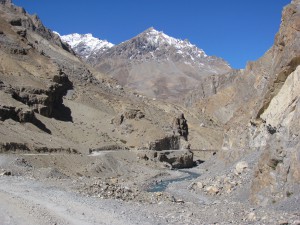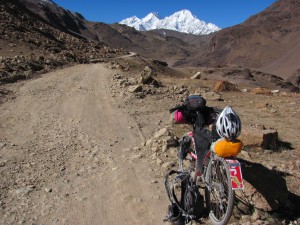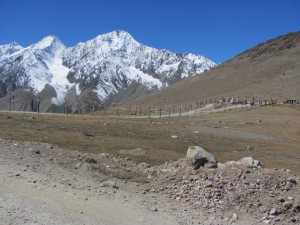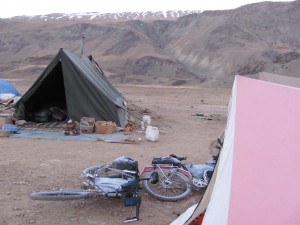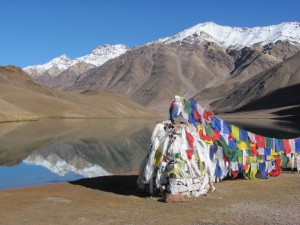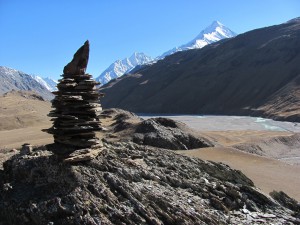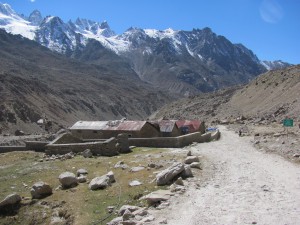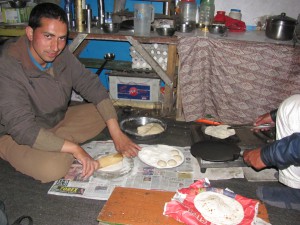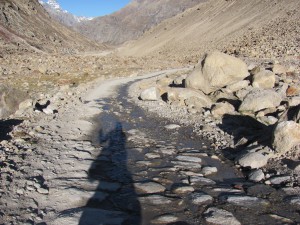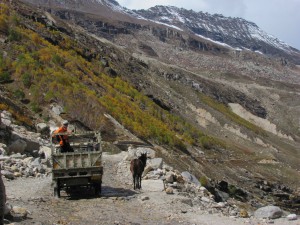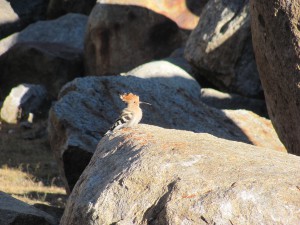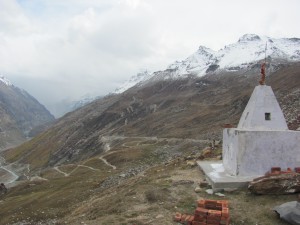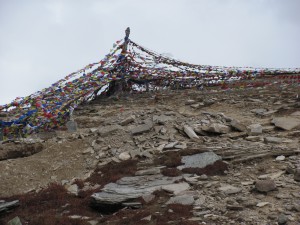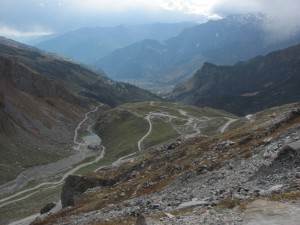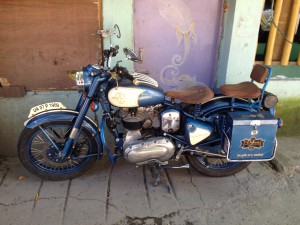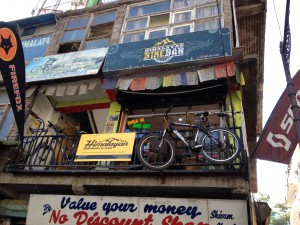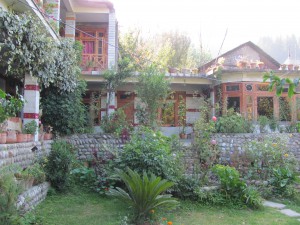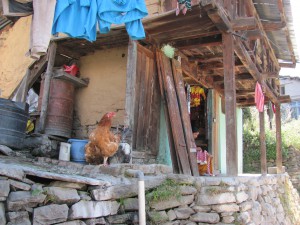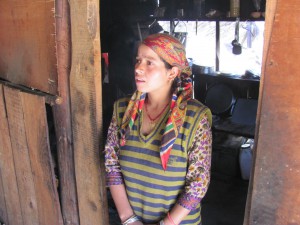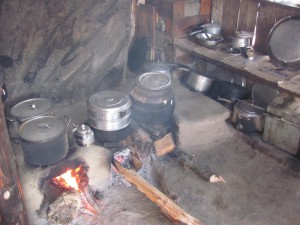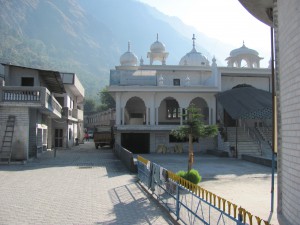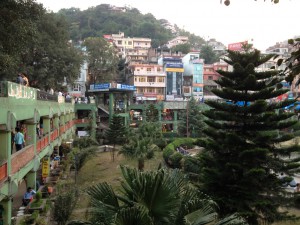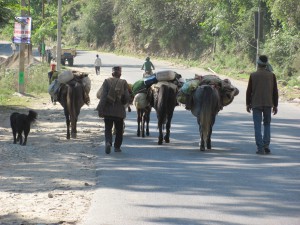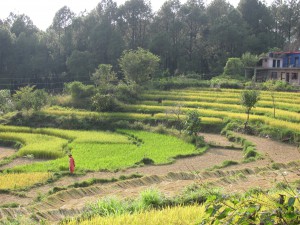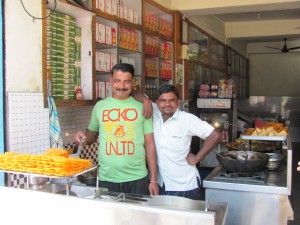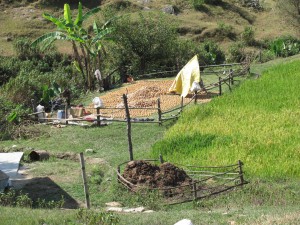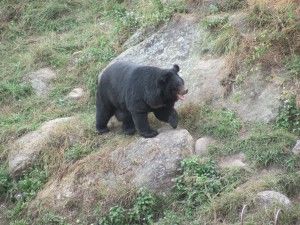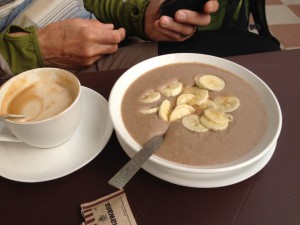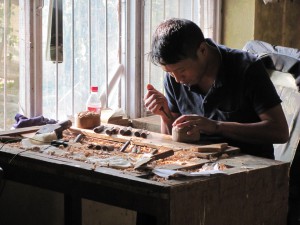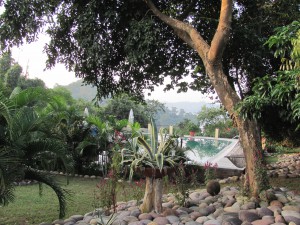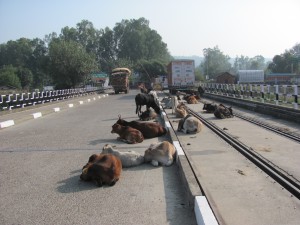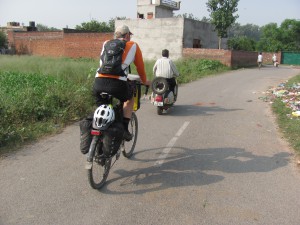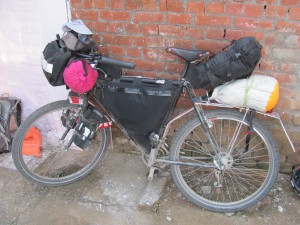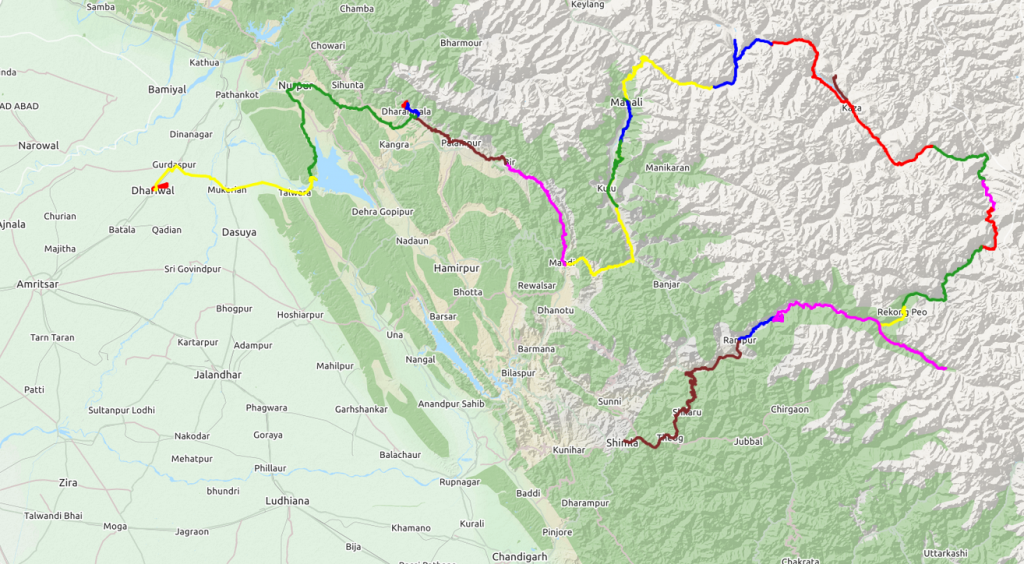This cycle trip was an idea that my friend David McCulloch had hatched about 2 years ago when he took a guided tour in northern India. He wanted to go further and needed a partner to join him so when he asked I immediately agreed to accompany him. How often do you get to go to the Himalayas where you’re never been and always wanted to, where your long time buddy was born and speaks the language? This was a opportunity I would not pass up!
Sept 1-8 – Wormerveer, Netherlands
Our journey began with a week-long stop in Wormerveer, Netherlands where David and I met up with our friend Bene who moved from Port Townsend back to Germany last year. We took casual rides through Haarlem, North Holland and the beaches, including ferry rides and tasty treats along the way. In the evenings it was a bottle of Beerenburg and some great conversations. On Sept 9 Bene headed home and we flew to Delhi, India to start our tour.
Sept 10-13 Shimla Pretrip
On Sept 10 we hopped on the shatabdi commuter train to Kalka, through the mass of humanity surrounding Delhi…was happy to be heading to the mountains. Our 26″ wheeled mountain bikes were safely in their cases as the coolies helped us load them in the bogie. Amusing to hear the announcements about a “discomfort score”…seemed to refer to delays at stations along the way. We then transferred to the narrow gauge “toy train” to Shimla, a large hill station in the Himalayan foothills. Two days later this same train derailed and killed two Brit tourists.
Got a room at Hotel White high on a ridge above the city near the Lakkar Bazaar. We built our bikes up and loaded them for the tour, then got our bike boxes sewn into linen bags for 230Rs to ship to Dhariwal in the Punjab where we would end our ride in 5-6 weeks. Shimla was my introduction to the iconic rhesus macaques – prolific, bold and at times a bit intimidating monkeys, especially near temples. We acquired leather whips for 60Rs to ward them off if they got to close, but never had to use them. The hike to Jakhu Temple dedicated to Lord Hanuman we did in 30min and the sign at the bottom of the climb said we were “absolutely fit”. Funny.
David introduced me to the world of Indian food, from Vaishnav Dhabas (all veg – the primary cuisine) to tikka and Kingfisher beers (only available in India). The cold he picked up in rainy Holland worsened so we spent time at the local doctor’s office and picked up supplies, dried fruit and nuts in Middle Bazaar. Took a tour of the Viceregal Lodge & Botanical Gardens. Met some 20yo Indian students and enjoyed time with them – the beginning of uncountable “selfies”. My guess is that by the end of our trip we’d been photographed hundreds of times…often getting pulled over on the road by overzealous, scooter riding youth just for a picture of us with them. Crazy fascination.
The next two days we waited out David’s cold, while I kept adjusting to the overall chaos, noise and entropy that is India. Had clothes laundered and folded for 195Rs! Must have looked spiffy as the hookers were hissing at us walking back from dinner. The harvest season Apple Festival was in full swing, so thousands of Indian tourists around. It was time to go and next morning we began our ride.
Sept 14 Shimla to Narkanda
We left at 8:30am…badly coinciding with the morning rush hour and school starts…traffic was unrelenting as we made our way to Narkanda. Diesel smoke, horns, and general mayhem, all while climbing in increasingly muggy heat for the first 10km to 9000ft. Hoards of apple trucks filled the road; Tatas, Leylands and smaller Boleros with apple boxes stacked high. In Theog we followed a ridgeline, where I hopped onto the back of a yak for a photo op. Shepherds leading goats, sheep and cows were all making their way down valley on the migratory passage to the fall markets.
Stayed at the Hotel Hatu in Narkanda and enjoyed a good dinner…many Indian tourists on a birdwatching nature excursion were also there. For the entire trip, we tried to have our bikes in the room with us whenever possible. This was sometimes challenging space-wise, not to mention hauling them up narrow stairways. Thankfully David’s Hindi was the key to all things, from getting us Indian and not Western room rates, better food and directions. Most places we stayed were quite accommodating for our strange cyclist requests.
Sept 15 Narkanda to Rampur
We headed toward Rampur in a steadily uphill direction. We choose to go counter-clockwise to acclimatize for the altitudes we’d eventually arrive at near Tibet and beyond, around 15,000 ft. This is the reverse of the Laura Stone route from her 2006 book, and much better. Had a long descent into the Sutlej River Valley, where it was over 100deg F and muggy, with lush tropical vegetation. Dhaba break in Nirath and a few shade breaks where we talked with some young men from Bihar who worked the grueling road construction season before heading back home for the Muslim Eid Festival. Got to the Hotel Busenar in late afternoon and strolled into the bazaar with it’s sandalwood infused smells. We found a good place to eat…which was challenging as the power kept going out, plunging us into darkness and the bartender would come in with a candle which would only stay lit briefly with the fan running full tilt.
Sept 16 Rampur to Sarahan
Left the hotel at 8am in cooler temperatures. Lots of deodars, cedars and palm trees in the valley. A brief stop in Jeori for bananas and water and a barber came out to chat. Up the street we stopped for tea at a tin shack where a group of older men kept offering us some of the local whiskey…no thank you. The poor suffering wife did all the work and the husband just barked orders. A bit uncomfortable to watch. Our goal was Sarahan, near the Shree Bhima Kali Ji Temple. A long climbing day, but beautiful and generally metalled (paved) with occasional water spouts to cool off in. Arrived at the Hotel Trehan for the night (400Rs/$6USD). A young man kept insisting to ride David’s bike, and it took many attempts to convince him that wouldn’t be happening. We both had colds acquired in Holland, but a brisk cold bucket bath at least got the sweat and grime off before walking to the temple. Beautiful hammered silver covered the statue of Bhima Kali and we noticed here the first blending of both Hindu and Buddhist traditions, which would continue till we got to Nako where it was mainly Buddhist. Enjoyed meeting two women from Mumbai who we would see a number of times over the next few days – they had just done a spontaneous trip on public buses and envied our bikes. Riding buses here takes far more fortitude in my mind. Stopped in a tiny dhaba for chow mein and met the lovely older couple who owned it, they said they serve no meat in respect to being close to the temple and we ate for a whopping 180Rs/$3USD each.
Sept 17 Sarahan to Chitkul
Woke to an awesome view – the first of the surrounding Himalayan Mountains. The rain all night had added snow up high and the sun was shining. Long, wonderful descent to Jeori for breakfast at a little dhaba below street level. The owner made us pakoras and chai – soooo good! Rode on past the ever more frequent military bases which are quite present in this area near the Tibetan border. The Chinese aren’t the most trust-worthy of neighbors it seems. The stretch to Nichar was reasonably good, which would continue only a few more kms till the landslides and road construction along the steep Sutlej River hillsides made the road a rough, muddy path. In Wangto, near one of the many hydro-electric projects, we stopped at a filthy tin-sided dhaba with drunk men and the most flies I saw for the entire trip. Combined with the heat, it was a miserable little shithole and I was very glad to move along. Seemed like the place I would contract some fatal illness, but my system handled the food just fine.
Before Karcham we came upon a long, steep detour which climbed up and over the ridge to avoid a huge landslide that had closed the road. After much discussion with a group of workers, we decided to attempt following the local villagers who were going through the slide on foot. Half the workers thought we’d never get our bikes through, the other half were simply amused to see us try! After rounding the corner and actually seeing the slide we questioned our decision. A temporary culvert crossed the river and above it, huge multi-ton boulders were strewn everywhere. On the opposite bank, rocks kept tumbling down into the river from 1000ft above. Very intimidating, and not helped by the bulldozer and excavator that were attempting to carve a new route through the chaos. Deafening metal on stone noise as the boulders were pushed and moved and we tried to push and lift bikes through it – one bad step or a shift with one of the huge boulders and we’d be severely injured or worse. Very unnerving and we were struggling.
Then, in one of the many magical moments of this journey, two villagers took pity on us, handing us their packages to carry while they shouldered our loaded bikes and carried them across – so adeptly that just following behind we couldn’t keep up. So humbling. After dropping down to the sandy shore we climbed back up and around the last of the huge machines. They put our bikes down and would take nothing we offered, simply saying in Hindi that it was no problem and essentially “good karma would come back to them in another way” – we were so grateful!
As this took over an hour to go about 1km, we soon found ourselves many kms from Sangla and Chitkul where we wanted to spend the night. The rough gravel climb ahead was relentless and we eventually ran out of water and daylight. Stopping at a tin-sided bus shack, we decided whether to bivouac there, where I could hike down to the river for water, or hitchhike. My typical reaction is to never take a ride while on the bike, but David’s cold and the long brutal day eventually made it a sensible choice. We flagged down a Mahindra Bolero apple truck and they agreed to load the bikes in the bed and take us to Chitkul, about 35km away for 2000Rs/$31USD, which was a steep price (on the local scale). It took nearly 3 hours to drive those windy, mountainous dirt tracks and we arrived well after dark. Found a cheap guesthouse and the owner was willing to cook us some dinner and lemon ginger tea. A bucket bath (in a washroom with 5ft high ceilings) and every bit of warm clothes we had on, we had made it to 11,000 ft elevation and went to sleep.
Sept 18 Chitkul Layover
Opted to take a rest day – the sun was shining and David felt horrible with an upset stomach, so after breakfast I took a long hike with Noga, a 20 year old Israeli woman who was traveling solo. Only 10km from Tibet, we were not allowed to hike as close to the border as we wanted, so we scrambled up the mountainsides below the Gaddi shepherds with their goat and sheep flocks. Was a beautiful morning, but after getting back and exploring the village, the clouds and rain returned with a vengeance. Spent much of the evening in the Thakur dining room talking with trekkers who were also there. I started feeling worse, coughing and feverish – the cold rain didn’t help and David was also feeling poorly. There is no heat in guesthouses, so getting under the blankets with all our wool on was the only respite.
Sept 19-20 Chitkul to Sangla Layover
Rode down the Baspa River valley to Sangla, through beautiful forests and small villages. Much more Tibetan influenced construction, stone and timber walls, slate roofs and painted polygon window borders. Was still cold and wet but fortunately only about 20km to the Shruti Guesthouse, which we choose simply because it looked pretty clean and we needed healing time. Turned out to be an exceptionally good choice, the owner was a Kinnaur area native and businessman, very organized. David felt better and went on walking tours of the temple with him, while I stayed inside. Broke the nose piece off my glasses. Constant rain. So happy to have a warm bed.
Sept 21 Sangla to Rekcong Peo
Restless nights and constant coughing – both a cold and the earlier dose of pollution, garbage burning & diesel smoke infecting us. Not making much progress and the impending thought of early snows was disheartening; would we be able to make it over the high passes in time? Still many more kilometers of ever deteriorating roads and higher elevations. We had one month remaining to arrive in Amritsar. Had we over-assumed our abilities? Climbs were hard for David’s chest congestion and hampered breathing. I felt OK, the rest days helped clear the cold, though we’d both cough for duration of the trip. Today we headed for Rekcong Peo to acquire the Inner Line Permits that would allow us to head into the disputed territory near Tibet.
Fortunately the day dawned sunny and dry, and we had a long descent to the Sutlej River. Saw huge Himalayan griffon vultures and even bigger views of the deep canyons below us. These are not descents to goof off on, a blowout or mis-judging potholes or rocks would be a one-way ticket over the edge – and they don’t rescue folks; if you can’t walk out you will die down there. Sobering thoughts, but risk makes adventure possible. Superstitiously I made offerings at all the roadside Hindu shrines or Buddhist chortens, just in case.
We arrived at a dhaba in Powari and had chai – the beautiful Nepali woman laughed at how sweaty I was. Too hot to sit inside the tin roof and walls, we stood under a closed shop overhang and acquired our regular crowd of curious people who would simply stand and stare at us. So common that eventually you just accept it; you’re never alone in India. Ever. Met UK and Spanish cyclists touring the opposite direction and got reports on the brutal road conditions awaiting us. All were fully loaded with huge panniers and our trim kit and my homemade coroplast fenders intrigued them. We didn’t carry stoves or tents and only minimal clothes, about 35-40lbs total, so our bikes were probably 1/2 what they had. Nice. We saw villagers bringing a linen wrapped body down to the river to be cremated while we ate some chips. Surreal.
The climb to Rekcong Peo was not difficult and soon we started the process of registering for our Inner Line permits (250Rs/$3.90USD). Unfortunately, the administrator who needed to sign them was gone, so we ended up spending two days waiting as they held our passports. Took advantage of the bigger town and found good pakoras in veggie, fish and chicken versions and a place to buy Kingfisher beers in 22oz bottles for 160Rs/$2.50USD. We had a room at the Hotel Fairyland (550Rs/$8.50USD) with hot water and TV. Met the police chief who chatted us up and loved David’s command of Hindi! He took us around and explained his important position in the town. This is a very ego and pride driven culture where status and caste is everything. He took me to a small jewelry making shop to see if they could repair my glasses. In true Indian can-do fashion, the young man meticulously super glued the nose-piece back on and bought us chai to share. They wouldn’t take any money for the work (which later the Chief told us was because he “handled it”).
Sept 22-23 Rekcong Peo
Permits weren’t ready yet so we took the local bus 8km up to Kalpa to explore the Buddhist temple and walk through the small village lanes and apple orchards. Was a damp day but a lovely village and temple. As we were walking, some ass hat in a car started yelling at a woman passing by to get a big rock out of the road, like it was her job. What a tool. We smiled at her and she laughed. Ran down through town and barely caught the return bus. Slept well enough, but on Sept 23 David headed for the local hospital to get his health checked out. I walked into town where I saw two cyclists, so went and introduced myself. Cat and Glenn were from Canmore, Canada and were doing the same route, except had ridden from downtown Delhi – not an easy task. They had made it to the Inner Line earlier and were turned back having no permit. I showed them where and how to acquire one and our hotel to stay so we agreed to meet up later. David acquired a vaporizer and antibiotics in the hopes of clearing out his frustrating chest cold.
Sept 24 Rekcong Peo to Pooh
Finally got out of town and rode most of the day with Cat and Glenn, swapping riding, skiing and life stories. They were good company. This was her very first bike tour – guess if you’re going to choose one, choose big! Glenn had ridden in Northern China and more. We made it to Puh (or Poo, Pooh, etc depending on the signs) despite 50km of muddy roads and construction all along the Sutlej river. Some reasonable pavement sections after the Kharo Bridge, and at Jangi we passed the secured Inner Line checkpoint where we filled out papers with the local police and they gave us beautiful crisp and delicious Kinnaur apples. The permits allowed us to be tracked until we exited at Sumdo and is only for foreigners traveling through. David was thrilled to be there as this section of road was closed while he was growing up in India.
We took a break in the little town of Spello (Spillow) and had a delightful lunch with a fellow named Mark Thomsen, an American from Hong Kong who had spent the last 3-1/2 months in the Spiti Valley and explored much of it on foot and bike. He was heading out, tired after so long, but he shared many interesting tales and insights. Would have enjoyed chatting more, but it was a great meeting of cyclists in this remote place. After riding some mixed terrain roads we arrived at the base of the climb up to Puh, about 10km uphill in the fading light. With 4 of us trying to find a hotel, the first wouldn’t budge on price, so we rode another 2km and found the delightful Hotel Karma (600Rs/$9.30USD). Cat and Glenn were next door and we all ate dinner in the dhaba around the corner, then looked out over the beautiful valley and moonlight from our balcony before sleeping.
Sept 25 Pooh to Nako
David coughed all night and got no sleep, while I got up at 3:30am to see all the stars – was so beautiful. We got some paranthas and omelets with chai, the standard Indian breakfast. Choose to ride along the ridge and not backtrack where we came up. Was a bit rough, but all downhill to NH-5. Cat and Glenn went ahead and the road smoothed out once we crossed the bridge over the Sutlej River and crossed into the Spiti Valley. With the sun shining, we now had a very long switchback road (called “kazigs”) to Nako. Mostly moderate grades on a good metaled surface, but the ascent was unrelenting. Enjoyed a dhaba lunch & chai for (90Rs/$1.40USD) in Ka (or Kah), a lovely oasis of fruit trees and water amid the stark, barren mountains all around. Such incredible vistas, and knowing we were so close to the Tibetan Plateau made it even more special.
We arrived in Nako about 3pm, with Cat and Glenn arriving before and telling us about the great food down the street. We got a room at the Galaxy Guesthouse (300Rs/$4.60USD) with a view of the valley below and the farmers harvesting fodder for winter. Donkeys were everywhere, making quite the racket with their braying. After a bucket bath we walked through town to Dr Shakshuka’s Cafe and had shakshuka – an Israeli dish with onions, garlic, eggs and tomatoes. Chased down with a lemon ginger tea. Delicious.
The four of us walked up to the massive, wind-driven prayer wheel on the hill, missed seeing the monastery, but the sunset from there was glorious. The sacred mountain of Kailash was bathed in alpenglow; just stunning. We strolled back through the narrow stone streets and houses, dodging piles of dung, watching women herding goats into pens and finding chortas around every corner. We had now reached 11,900ft and thankful for the last few weeks of acclimatization.
Sept 26 Nako to Chango
Cat and Glenn left early, while we started a half hour later, after a long 10 hour sleep. Beautiful sunrise with echoes of bellowing donkeys down in the fields. Again to Dr Shakshuka’s for porridge. We’d need all our energy, as soon we would cross the massive Malling Slide from 2005 – still not entirely cleared or repaired. It was everyone for himself as the rocky and muddy track tilted up and through road workers and equipment. Smaller rocks fell on the road and there was the eerie feeling that it could slide again. Hard to explain the size, but easily a kilometer or more across and from over 12,000 feet all the way down to the river. Epic scale. Due to the trucks, I ended up walking 50 meters through a muddy section, then rode across the rocky stream at the top. Women were hauling bags of rocks to the edge and dumping them down the steep slopes below (the “cud”). Passed a huge multi-ton boulder that had recently fallen onto the road and finally arrived on the other side. I waited for David who had to walk much of the way, feeling pretty rough.
After that episode was an incredibly long descent on broken pavement that erased all the elevation we had gained. My rack bag bounced off again, so this time secured it with line and that worked for the rest of the trip. Down at the Spiti River it was hot, dusty and the road was washboard sand. Every vehicle that passed created a small dust storm, so we rode with bandanas over our mouths so not breathe in any more dust and diesel than necessary. In a short time we arrived in Chango, where David announced that he was done for the day. With only 25km covered he was too sick to continue. I was in a quandary about whether to split up and go on or stick together, but it was wiser to stay together. Felt so bad for him, but nothing to do about it. The meds were not helping and he felt weak. Every climb took him off the bike to walk…little did we know then that this would continue for a long time.
While the bus stop and bridge intersection in Chango was hot and chaotic, we did find a simple room above the dhaba on the south side where the owner was very welcoming, giving us apples and a tasty chow mein lunch. Now that we were in Tibetan territory I could finally eat something other than rice, dal, paranthas, omelets and chapatis, which was welcome. We napped and then strolled up to the village through stone walled fields of potatoes and fodder with a monastery high above us. We arrived in the upper village and stopped for bananas and salty “Punjab Todka” snacks. Met two Nepalese metal craftsman who make silver and gold items, all extremely detailed and beautiful. I asked them about whether they sign their work and they said yes, except for the statues in monasteries – for those he said they can just walk in and recognize their work right away! He pulled out a photo album of what they’d done and it was simply amazing. Some of the statues were pure gold and over 5 feet high. All produced while sitting barefoot on a small cushion hammering away on a short legged table in minimal light. Took “artisan” to a new level. Soon they would head back to Nepal on a 5 day bus ride, where they would visit family and live in their earthquake damaged villages until March when they return to Chango. There is no work at home, or fuel and power for that matter, so they were some of the many Nepali people we met who have become transient workers trying to make a living. Sobering.
In the lower village we met a fellow named Bumi Negi and he invited us to his older brother’s wedding that night. Seems the mainly Buddhist Kinnaurs only get married when they are ready, though can be together and even have children, as these two had done. Their kids were already 8 and 10 years old, but the bride had been living with her family. Now they would both share his house and start their own life. It’s partially due to cost, but so unlike the traditional Indian scenario of dowries & parents choosing mates, caste issues or extravagant weddings (sometimes costing $130,000USD). These people were more reasonable and reflected simple Buddhist traditions.
We had a wonderful time, first being seated to eat with the other townsfolk and anyone else who happened to be in Chango that day! Decorated with festive tents & flags, the wind was blowing hard and making a racket. We all sat on rugs along low tables and ate salty and sweet snacks, salt tea and whiskey with a dab of ghe (butter) for good luck. We smiled and chatted with many and they were gracious in showing us what and how to act – having never been at a Buddhist wedding before we had no clue. After that, the ceremony began with drumming and six Buddhist nuns led a snake-like procession around the compound. They wore elaborate head-dresses, silver jewelry and long dresses. Monks and family members spoke and eventually the seated bride and groom were showered with literally mounds of gifts – and each were draped with a Buddhist khata (scarf), which nearly buried them in cloth. We left before all was done, having been warned that the celebration could go well into the night, and it was time for us to sleep.
Sept 27 Chango to Tabo
We packed up and left by 6:30am, hoping to avoid heat and traffic. David felt slightly better as we headed to Tabo. A small dog had become my little buddy and followed us for many kilometers until I told David it was making me sad to have this poor animal follow knowing it could not come home with me as I would have liked. Never got used to the harsh way people treated dogs in India, and knew that this dogs life was brutal. It made me cry.
The road was rough, but eventually we made it to Sumdo at the confluence of the Spiti and Pare Chu Rivers which was the end of the Inner Line and probably the closest to Tibet we came. Another checkpoint to sign papers and then into ever more fantastic vistas of the turquoise Spiti River, mineral deposits spilling down from thousands of feet above tree level and green oasis’ amid all the shades of dry brown earth. This was the portion of the route I was most looking forward to, countless views of the Himalayas and much less traffic. The roads were rough and would get even rougher ahead.
A note on our equipment. As we’d chosen to use unsuspended 26″ wheeled mountain bikes, the 2″ wide Schwalbe Mondial Marathons, Brooks saddles and our legs were the suspension. It worked fine, though nearly every cyclist we met had suspension. It’s not necessary but some folks don’t mind the excess weight. For the entire trip the only issues were some loose rack bolts and David broke a chainring bolt which we replaced in Bir with a machine bolt. A perfect, simple solid setup. We only saw 3 bike shops…none of which carry western style parts…except chains.
We had not eaten breakfast yet, so in the village of Hurling we saw two guys making paranthas on the concrete slab in front of their dhaba. We stopped and ordered, and soon had two thalis (metal plates with sections for different foods) with paranthas, dal and a curd mixture. From the first bite this was hands down the best breakfast of the whole trip, we ordered seconds and chai to wash it down (80Rs/$1.25USD). The sun was shining with huge, deep blue skies above and a slight breeze. Old men sat about and I fed some cashews to a stray dog. We wondered why they kept making more paranthas when we were the only ones there, but turns out the scheduled bus was coming through soon. Otherwise the street was very quiet. A perfect stop.
We arrived in Tabo before noon, found the monastery guest house and secured a room for the night. They had a nice cafe with outdoor seating and we consumed delicious veg thukpa (wide noodle soup) & momos. We strolled over to the Sonom Cafe for our first coffee since Shimla and met a young man named Lonsom who provided good info about the route ahead. Outside the cafe two kids were having their heads shaved and they loved going through the photos of themselves on my camera.
The monastery from the outside looks so plain, with mud/dung and straw walls and no golden stupas. Learned that this is why it’s one of the only Buddhist monasteries that weren’t sacked by invading Sikhs or Mugals…it didn’t look worth the effort. Inside though, are scores of thangka paintings and murals on the walls, some dating back to 996 CE. No photos allowed, but we sat in on a monk teaching some villagers and enjoyed chai with them. The room was only lit with candles and natural light from above. Nearby was the new hall under construction, with a huge Buddha thangka inside. We then hiked up to explore the monk’s meditation caves and a small assembly hall perched on the cliff. We finished the day with a walk to the agricultural research station and short tour from one of the scientists who are exploring the organic growing of dozens of fruit varieties. Dinner back at the cafe by candlelight as we lost power again…we never went anywhere without headlamps, just in case.
Sept 28 Tabo to Kaza
We wanted an early start to Kaza today and were told that breakfast could be had by 7am…but in usual Indian fashion, it wasn’t until 8am that everyone’s pujas (prayers) were done and the cafe opened. Time here is elastic. By 9am we got underway after witnessing two dogs stuck together and running around butt to butt…seems reproduction caused some unplanned attachment.
Rode the undulating road past bridge washouts, nalahs (slide area), and a widening valley with the braided Spiti River running through it. Saw some oxen-powered tilling and a few motorcyclists on Royal Enfields making their way through the same rocks and water crossings we did. In Schilling we opted not to take in the Dhankar Monastery with its long and steep climb, which we later regretted not seeing. From Lara, the road smoothed out and we had a welcome tailwind all the way to Kaza.
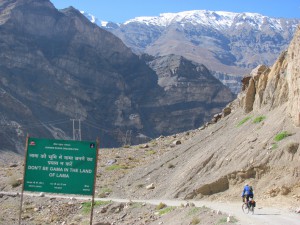
The sign says it all…but what is “gama”? Himank signs of the Border Roads Organisation (BRO) in the Ladakh region are always interesting
Kaza is a busy town and like Manali, one of the hubs for trekkers, tourists and motorcyclists. We secured a room at the hotel (800Rs/$12.50USD) next to the Mahabudha “World Peace” Restaurant. Was comfy and warm enough, with intermittent power throughout the town, as usual. Ran into Cat and Glenn again, who were both battling illnesses from her fevers to his gut issues. They were taking a few days to recover, so over dinner we opted to stay ourselves and visit Kye Monastery and Kibber by taxi the next day. Dinner included my introduction of Sha Bak Lay veggie turnovers, which became an obsession to find from then on. Like a Tibetan egg roll, they can have mutton or veggies and are simply delicious!
Sept 29 Kaza Layover
Wanted to keep riding to Kibber today and take the julley (cable cart) across to Chichim while the weather was good, but David needed more rest, and no one else wanted to risk the cable trip. Definitely on my agenda next time, before the bridge is in place. Our day to explore the monastery and Kibber, with fantastic views and a bharal or Himalayan blue sheep sighting, plus learned about barley harvesting, which was in full swing throughout the valley. Attempted to eat at the trendy “Taste of Spiti” we had visited for lunch, but breakfast took an hour and was mediocore. Did get to try the supposedly magical seabuckthorn juice though, maybe it’ll give me wings? Getting pokoras on the street was much more satisfying. Mark, who we met in Spello, had suggested the Sol Cafe for seabuckthorn chocolates, but unfortunately they were already closed for the season. We bought some wifi time at the electronics shop, but the power went out shortly after paying. Oh well.
Sept 30 Kaza to Losar
Packed up early and left Kaza by 7am – 35deg F and sunshine. The road workers were heating the drums of tar for the days repairs, the black smoke rising into the blue sky.
Found a nice dhaba in Hull with good omelets, chapatis and chai. Crossed the bridge over the Spiti at Kiato, where the road from Kibber-Chichim comes out. David was feeling better and the headwinds after Hanza were tolerable.
We made it to Losar by 4pm and got one of the last rooms in town at the Tenzig Guesthouse (400Rs/$6.25USD). Enjoyed a solar heated bucket bath and headed to the restaurant for Tibetan style veg Manchurian and lemon ginger teas. At around 12,500ft it was cold. Cat and Glenn came in after 6pm, totally knackered. They struggled to find a place to stay and ended up spending a lot of rupees on a 4 bedroom space, but they were glad to have something and were immediately asleep.
Oct 1 Losar to Chandra Tal
Today was the climb over Kunzum La, our highest pass at 15,000ft. We ordered potato and cheese momos to take with us after breakfast and were gone by 7:30am. Of course we forgot to pick up the momos before we left. Had a police checkin just outside of town which took a bit of time as the officer wasn’t finished shaving. We continued on the rough track trying to keep feet dry through frozen puddles and creek crossings. Stopped to secure our loads and tighten some rack bolts, as the constant jarring was tough on the bikes (and us). We were passed by many motos and trucks, and an occasional bus, which were the least likely to allow us any room. Then, a small truck pulled up and the driver handed us the momos we’d forgotten! Very sweet surprise and another show of the wellspring of generosity we encountered in India.
The grade from this side of the pass is moderate, but continuously up. Switchback, climb, switchback, over and over. A few nalahs with “live stones” (active slides) and rocks spread across the road added to the excitement. Past one of the bridges I stopped to wait for David who ended up walking much of the climb. Could tell he was not feeling well, while I was feeling stronger every day. It didn’t seem fair. We made the top of Kunzum La at 15,000+ft by noon and circumambulated the stupas amid thousands of prayer flags. We hugged and celebrated this milestone as the wind and cold required adding more layers for the precipitous descent. Going down this direction made far more sense then the typical cyclist route up, and with construction, small slides and water crossings it would have not been an enjoyable ascent. We had to stop occasionally to cool rims from braking and rest our hands. But what a magnificent panorama surrounded us, truly breath-taking (about 40% atmosphere compared to sea level). We reached the turn-off for Chandra Tal and had photos with some motorcyclists who thought we were crazy. Some auto tourists asked me which road went to Delhi, which I pointed out but had a good laugh…I must have looked knowledgeable or something!
David told me to go ahead a find a site at one of the tent camps. He wanted to take it slower for the final 14km. Fortunately the road rose for a few kilometers, but then hugged the ridge-side above the Chenab River in a gradual descent to the broad plateau below the lake. Arrived and a guy named Raj came to talk to me. He had a tent at Jamaica’s Camp (500Rs/$7.80USD per person) including breakfast and dinner. We were at 13,500ft here and the idea of sleeping in a tent was allayed when I saw all the comfy blankets & quilts on top of an ensolite pad – seemed like we’d be warm enough if we had enough wool on. David pulled in about 45min later, happy to be done for the day.
Turned out to be a magical time here. Raj was the most engaging man, making us omelets and tea for a snack which wasn’t actually included in the price. Dinner wasn’t till 8pm, long after the sun went below the peaks surrounding us. We took a long walk and tried to bushwhack to the famous lake. David decided to head back and I kept walking another hour or more till I finally saw it. By then it was getting dark and cold and it took another hour to hike back, just in time for chai and dinner in the group tent. Treated some water from the sketchy looking spring and put on all the clothes we had. There was a small wood stove in the main tent, which they fed with wood, paper and sometimes plastic…so good for a cyclists lungs. They had offered to let us stay in there for less money, but 200Rs more got us cleaner air. Soon we were under blankets and zipped in, with our bikes laying in front of the tent. Felt good to sleep, but was awakened constantly by vehicles, people talking and music blaring from the next camp, then some guy puking from altitude sickness till 1am. It all started up again by 5am, so not the most restful night.
Oct 2 Chandra Tal Layover
Woke up to frozen water bottles but once the sun came over the peaks it warmed up nicely. Decided to stay one more night despite the temps going into the teens. Raj made us paranthas with jam, then we hiked a few km to the lake for photos while the winds were calm. Such a beautiful and sacred body of water, Chandra Tal is like a mirror for the peaks above. Truly gorgeous. The air warmed up considerably and we hiked back to sit and chat with Raj. He talked about simplicity and what we would choose if we could only have “100 Things”. All in all, a nice day, with the exception of some young punk who kept racing his moto through the camp…I contemplated many acts of sabotage for that moto.
Despite this being a sacred place, most Indian tourists treat it as a dump, throwing trash everywhere and generally oblivious to that fact. This is the case everywhere in India and hard to comprehend from my Western perspective. Nothing to be done about it though and even in the USA I see folks throw garbage in the most beautiful places.
We spent the last night in the main tent having dinner and talking with Indian motorcyclists, a French Sikh and a young graduate student taking a long weekend to relax and take photos. Much quieter tonight and we got a good sleep despite freezing temps.
Oct 3 Chandra Tal to Chhota Dara
Sad to leave, but it was time to ride. From now on out would be the most brutal stretch of road until crossing over Rohtang La. Mainly just a path carved over the riverbed, it ranged from sand to football-sized rocks, water crossings and everything in between. Probably rode about 4km/hour much of the time. We made it to Batal, with a rough little seasonal dhaba and public works area. We had some chai amid the scores of motos and trucks stopping here. David was feeling tired already and we’d only covered 20km. It was unknown what lodging we could find, but most truck stops have at least a rock-walled space with a tarp over it to stay. We had a headwind, but weren’t going fast enough for it to matter.
We took a break upon reaching Chhota Dara, a public works rest house that looked abandoned. David said he was done and wanted to hitch-hike. I wanted to keep riding but we had to choose, so I felt better staying together. Fortunately, this turned out well, as a guy drove up and said he was going to visit his cousin the chokidar (caretaker) of the rest house. He arranged for us to stay there (500Rs/$7.80USD) which was a huge relief. No water, power or blankets, but we had our sleeping bags and there was a thin mattress no one had slept on for years. Fine with us.
We only had nuts and dried fruit with us but were pleasantly surprised to be invited into the chokidar’s dark, tin-roofed quarters for dinner with him, his cousin and a Nepali scientist who was studying the nearby glaciers. (Public works rest houses typically don’t offer food). They had spicy chicken (chopped up, bones and all), subdje (cauliflower and onions) and chapatis. We shared a bottle of homemade whiskey and David translated all the talk for me thankfully. They were totally enjoyable company and another one of our Indian adventures to remember fondly. We took our leave by 8pm, hoping for a long sleep in the silence of this remote place. David and I discussed the next day’s strategy. He opted to hitch-hike/bus, while I would ride the 100km over Rohtang La and meet him in Manali if all went well.
Oct 4 Chhota Dara to Manali
Awoke at 5:30am, with a bit of an upset stomach. Final packing and said our goodbyes…felt weird not to be riding together and wished each other luck on our separate paths. The sun was out again and it was actually nice to have some solitude in this beautiful place. Saw many birds and few vehicles as I made my way, even getting passed by the chokidar, scientist and the cousin on their way to find cell service. The “road” was horrendous but at least moderately rolling. Stopped in Chhatru for a parantha and chai and saw the scientist there, plus a fellow we’d met in Tabo who remembered me. Small world. Took an extra parantha and filled water as this was the last inhabited place until over the pass. I felt really good too.
The climb began shortly after, constantly rising every kilometer and in one water-filled section opted to walk alongside the horses who were roaming around, which I am always loathe to do. At that very moment a truck came from behind and there was David standing in the back with his bike! He made sure to chide me for my weakness as he bounced along and into the distance. Frankly was happier being on the bike, he looked a bit battered in that truck bed!
Ran into two South Americans cycling the opposite direction, Henri and Eliza. I didn’t envy them as the sky behind me was black and ominous, but they were undeterred. Invited them to stay in Port Angeles, as they were planning a future trip to the Olympics and they recommended touring in Chile. A wonderful chat. Wish I’d gotten their contact info.
The winds were now getting stronger and the temps falling as I kept climbing to Gramphoo where I would swing left and up to the pass (right brings you to Keylong and the road to Leh). The “town” was simply a switchback with a few buildings and broken down Tata trucks. Having been dry for a few days the sand starting blowing across the road and into every part of my clothing and eyes. Had to put on all my layers and still was cold despite the steep, winding climb. About 2km from the summit there was actual pavement, which at least made riding a bit easier. Rohtang La (translated as “Heap of Souls”) is know for it’s fierce winds and storms, so I was experiencing it firsthand. Light snow flurries skirted by, but finally made the top and through the gauntlet of Indian tourists in their “snow dresses” (rented snowsuits). Traffic was insane and only later heard that it was a holiday weekend (Gandhi’s birthday) – hence the crowds.
With frozen feet and hands a young man took my photo for me and I spent little time there, soon passing over into the Kullu Valley with it’s lush vegetation and warmer temps. The descent was intense, mostly paved with narrow sections of washed out rocks and mud. Far too many ego-driven Delhi tourists speeding downhill and many times was nearly pushed off the road until I finally just went on the offense and took the whole road. Cars could not hold the same speed as me, so once I cleared a wave of cars (they drive bumper to bumper with horns blaring at all times), I had a few minutes of road to myself. It was over 50km to Manali with a 6400ft drop. What a descent!
Only when I’d reached 5km from the Manali turn-off did I start to warm up and could take off some layers. The sun was already setting so was happy to be down. We’d agreed to meet at the Veer Guesthouse (500Rs/$7.80USD) in Old Manali so that’s where I headed once I crossed the bridge. It was 3km of steep climbing, but soon saw David walking down the hill. Woo Hoo! We strolled to the guesthouse talking about our day. He had gotten out of the truck and completed the descent so ended up not riding for only a couple dozen kilometers when I saw him.
After dropping off gear we had dinner in the Yun Cafe with Korean Beejobi pork, veg, rice and lemon ginger honey tea. Headed across the street to the Hangout pub for a few beers. A hot bucket bath and my 16 hour day was successfully complete.
Oct 5 – Manali Layover
Awoke and went to the cafe for breakfast where we met Benti, a tour guide from Belgium. He and David both had health issues and went off in a tuktuk to the hospital. I decided to explore The Mall, but along the way heard someone call my name and there was our Canadian friends Cat and Glenn! Joined them at Dylan’s Coffeehouse, a very popular spot for foreigners and good coffee. Met Lena from Denmark who lives in France, teaches skiing, rides bikes, travels & crochets with her eyes closed for mediation. We all sat and talked adventures for three hours and could have kept on all day. Cat and Glenn hopped a bus to Rajasthan & Gujarat, having not quite recovered and deciding to curtail their tour with a week on the beach. David and I had dinner with Lena at the Yun Cafe and then watched cricket and had Kingfishers at the Hangout.
Oct 6 – Manali to Naggar
Off to Naggar today, but met up with Lena, Tom (who had just attempted a new route on Nanda Devi) and Suz for coffee before we left; they were heading to Delhi and back to France. We scored a couple yak cheese veg rolls for the day and stopped in The Mall bike shop for some chain oil – which despite having three bottles of it, the guy at the counter was convinced or confused about whether he could sell it. Took 1/2 hour to convince him and chat with the owner by cell that it was OK. Geez. Only in India can the simple be made so complex.
We threaded the busy traffic and crossed the Beas River to head south to Naggar. Now in the Kullu Valley temps were high and air muggy, with more pollution and traffic. Went through many ratty little towns with happy, smiling people. We reached a traffic halt where some iron rod was spread across the road. David was ahead and while stopped the car behind bumped into his pannier. Instantly he started admonishing them in Hindi – not at all what they expected – a pissed off, tall white guy!! The six guys in the car started apologizing profusely in Hinglish “so sorry sir, so sorry!” A woman watching started laughing at them. It was hilarious in hindsight…David’s typically so calm – surprise!
Arriving early, we turned up a steep 2km road to Naggar Castle, took a quick tour, then rode to the Nicholas Roerich Estate & Gallery. He was a very famous Russian, quite the renaissance man, artist and adventurer. Enjoyed touring the grounds, seeing the beautiful paintings and reading about his expeditions. Such an amazing person! Met two fellows, Irish and Indian, who told us about a place we could stay, so we then headed to Chandra Lok guesthouse (500Rs/$7.80USD). Really sweet place and the lovely woman who ran it was the daughter of the people who owned the Yun Cafe in Manali – small world again. Over dinner watched Indian soap operas, strolled through the village for a couple beers, then a restful sleep.
Oct 7 – Naggar to Bhuntar
Had a rough idea of where to go today and were encouraged by a route across the ridge our guesthouse owner suggested instead of dropping back to the busy, hot, valley road. Porridge and chai for breakfast, but had to wait for our passports till 10am. All lodging in India (if it’s legitimate) requires paperwork and passport copies. Many times our passports would be running around some remote place on someone’s scooter as they looked for a “photostat”. Fortunately we always got them returned.
This was one of those days when the fact of our mode of travel did not come close to the locals concept of travel. In India we found that no one knew the distance, direction, or difficulty of any road. Not even the signs were correct, and there are no maps. Lonely Planet wasn’t even correct, so generally we had to simply go with our gut. The “low traffic” route through the woods turned out to be a four hour climb on ever deteriorating road and a rapid descent on washed out dirt paths. We gained no real forward distance compared to the main road…but once committed, we had to continue, though I doubted we would actually get out of the woods. At the top of the climb was 2km of mainly a rocky creek bed, which I rode up, barely.
We managed to find a nice wood and tarped dhaba near the Jana waterfall. A lovely Punjabi woman, with her baby sleeping under a mosquito net, made us a delicious thalis with red rice, mustard greens & corn chapatis over a wood fire while we listened to some men argue loudly about the upcoming elections in Bihar. Prime Minister Narendra Modi was a constant topic and everyone we met either loved or hated him…pretty much the same issue in America it seems. Was more interesting to watch the woman watering the dirt road to keep the dust down.
Made it the the main NH-22 in late afternoon on the left bank of the Beas River. Stopped at a small dhaba run by a wonderful Sikh fellow who made us food while we munched on Lay’s Magic Masala chips and cokes…our go-to treats we sought out when the hot weather required salt and energy. Yum. Fun watching all the students in their uniforms come in to pick out candy after school. The owner told us we could stay at the Sikh gurdwara in Bhuntar, so that’s where we headed.
The gurdwara was an amazing experience – the administrator was an older Sikh named Billou who had run a restaurant in Berkley, CA for many years & knew about cycle touring too; and invited us into his office for chai and told us about the basics of Sikhism and being a bachelor. We then went to the langar (free food to anyone who shows up) where we sat with truckers and ate dal, rice and chapatis. As always, we had shoes off and head covered. Explored the temple afterwards and then settled into our room for the night. They put us in our own space as they said the truckers in the dormitory “weren’t all that clean”…guess they didn’t look at our grimy, sweat-encrusted clothes and faces closely!
Oct 8 Bhuntar to Mandi
Started the day with chai and said goodbye to our wonderful hosts at the gurdwara. Crossed the bridge into massive traffic jams of buses, trucks, horse carts, bikes, cows and pedestrians. Slipped into a street side dhaba for paranthas. Once back on the road we enjoyed pavement and descending along the river past many temples as the heat rose and monkeys increased in number. We both felt good, despite the pollution and volume of distractions. Found the Sheri Hotel (500Rs/$7.80USD) which was cramped but the geezer (hot water heater) worked, so had a hot bucket bath to wash off the dirt.
Strolled into town to the two story open air shopping mall where I found a replacement t-shirt and batteries. David had been here on a tour in 2013, so we stopped for dinner at the fancy Rajmahal Palace Hotel for trout and a pile of meat for protein. After that was the sweetshop (David is addicted to Indian sweets!) for milk cake and barfi. I tried a taste of them, but sweets are not my thing. Got an autorickshaw back to the hotel and went to sleep amid much traffic noise.
Oct 9 – Mandi to Bir
As we left town around 8am I realized how much happier people are in the morning. Very nice feeling to hear constant “good morning sir”! Took NH-154 which climbed till we eventually stopped at a nice dhaba for chow mein and bread omelets (basically a piece of untoasted bread with egg coating). The owners wife was working in San Jose, CA and he was waiting for his visa to go visit her – after a year apart. His young helper rode a bike with wires poking through the seat and I wished for a way to get him a new saddle. We had one tunnel to navigate, but it was pretty well lit and under 2km long.
Vegetation was lush and tropical, temperatures high and the fields became mainly rice and tea plantations. Most of the tarmac was in good condition and mostly uphill. After a stop for red rice and dal we entered the sheer chaos of Joginder Nagar for pakoras. Winding through town with hordes of motor vehicles, cows, dogs, tuktuks, bicycles and people – a most thrilling spin requiring high concentration. The one constant is that no one cares what’s behind them, so random pullouts, doors opening, peds walking into the street and oblivious cows meandering everywhere meant one’s attention never wavered or you were doomed. Exciting.
Before Chauntra we took a right onto a smaller road to Bir, a Tibetan Cantonment and internationally known paragliding mecca. Stupas and trapezoidal Tibetan homes and buildings everywhere. Pulled our bikes over a washed out street and up to the Green House & Restaurant for the night (500Rs/$7.80USD). Wonderfully clean, with wifi and good food. Discovered the Indian government actually requires a permit for foreigners to stay in these cantonments, but the owner said for a single night it should be OK. Then he told us about a mean local dog that silently sneaks up behind you and bites…not a comforting thought.
Oct 10 – Bir to Sidhpur (Norbulingka Institute)
Had porridge for breakfast then, just as we were about to leave David broke off a chain bolt, our first real mechanical. Fortunately there are two bike shops in town (being a big adventure hub), so we finally got one of the shop owners to come down and open up. While we waited, at least 20 men and kids stood staring at us saying little, but the kids were all smiles and curious about shifting and brakes. For most, the sight of multiple gears was quite a novelty. After two hours we finally found a machine bolt that fit. Seems all bikes sold in India only have one piece cranks and pinned chainrings…
We rode through even more lush vegetation and numerous small villages. Women walking down the road with piles of fodder on their heads were a frequent sight. Our typical “Namaste” greeting was replaced with “Tashe Delek”. Stopped in Palampur for some of the best onion, chili, cauliflower pakoras ever! So yummy. Passed a very large monastery along the way, which seemed to fill an entire ridge.
Much climbing ensued on never ending ridges, but fortunately in shade most of the time. Took breaks along the way for Magic Masala chips and cokes, with one quiet hillside dhaba having comfy rope beads to lounge on. Came across a strange Asian bear zoo which was somewhat sad looking. Arrived in Sidhpur and climbed toward the Norbulingka Institute where we found the simple Green Homestay for the night (500Rs/$7.80USD).
Oct 11 – Sidhpur to Mcleod Gunj/Upper Dharamsala
Woke early and walked to the Norbulingka Institute’s temple and grounds. This is the main place for preserving Tibetan arts and crafts: thanka painting, metalwork and weaving. They also have a pricey guesthouse and cafe. The grounds are spectacular. Such a beautiful space and there’s even a special bedroom in the temple for when the Dali Lama comes to visit. Now in the Kangra Valley we then began the long, winding climb to Dharamshala and Mcleod Ganj where the Dali Lama lives in exile.
Arriving in Mcleod Ganj, we found a room at the Green Hotel, unfortunately on the lowest level and damp. Black mold and soggy blankets, but reasonable (600Rs/$9.30USD) for such a tourist trap town. Got our laundry in the queue for the next day and had some lunch on the deck. A stroll through the crowded bazaar to the large Tsuglag Khang Dali Lama temple. Looked for some good places to eat and got lost in the maze of paths and side streets.
Oct 12-14 – Mcleodganj Layover
Everywhere is overbuilt and crowded, but we found the Cafe Tibet Cafe which would become our go to breakfast place and the only spot with tsampa (barley) porridge; very delicious and filling. They also made the best coffee on our entire trip and the young man who made them took great pride in crafting artful cappuccinos – which he learned watching youtube videos!
Decided to stay longer and hike to some spots above town that David knew from childhood, Alfred Hallet’s old house and the Butterworth family’s properties. We found them and David was pleased to make the contacts he was looking for. On the way back down, the fog rolled in and the temperatures dropped. Troops of rhesus monkeys were everywhere. After our four hour hike we headed to a touristy Mc’Lod restaurant for a tasty but expensive chicken masala and biryani rice lunch and beers (1100Rs/$17.00USD). It had a good view of the main intersection which was amusing chaos.
Awoke Oct 13 to more fog, so no views of the Himalayas again. Managed to find David’s bike tour guide Vijay from 2013 who also drove a taxi and we took a car tour of Naddi where we met an old friend of David’s family, Mahdo, who was their chowkidar in the 60’s. We shared tea and cookies in their tiny home as they all talked about the old days. It was a nice glimpse into real Indian life. We returned to town and when Vijay parked the taxi we saw almost 100 more all parked on the hillside – this place is simply over run with tourists and we were just lucky that it wasn’t high season. Crazy crowded.
Ate at the Tibet Kitchen and enjoyed some traditional doughy steamed bread with mutton, black mushrooms and bok choy over rice for only 240Rs. Dinner was soon after with chicken tikka at the Hotel India before we decided to get beard trims and haircuts…which turned out to be basically an overly expensive shearing by an arrogant barber we now refer to as the “Butcher of Mcleod Gunj”.
Woke up Oct 14th feeling like crap, so drank lemon ginger honey teas and slept most of the day while David went hiking. A huge rain and wind storm blew in, thrashing the tents and awnings over a Hindi wedding party below the hotel and causing floods in the streets that made the sewers gush their foul contents everywhere. As in most places outside of the very largest cities, most waste is simply run out to hillsides to spill into the rivers. It was disgusting, but you get used to it.
Oct 15 – Mcleod Gunj to Sidhpur (Norbulingka Institute)
We opted to ride back down the short distance to Norbulingka to see the workshops we couldn’t see the last time. We returned to the same hotel and toured the Institute, then walked downhill to the Brishta Restaurant for tasty pokoras while overlooking the bus stop on this busy road. On the way back I ran into Hanna from New York who I’d met a few days before. We sat in the sun and chatted till she had to catch her bus. She was traveling solo and wanted to see our bikes but we never saw her again.
Oct 16 – Sidhpur to Basunti (Pong Reservoir)
David finally made contact with a family friend and we were invited to stay with them at a retreat on the Pong Reservoir. This sounded much better than heading straight into the hot Punjabi plains to Dhariwal. Turned out to be a 120km day in hot, busy traffic but generally descending. Lots of young men on motos stopping us and insisting on selfie photos.
We didn’t know what to expect, and the garbage strewn, washed out dirt road we had to take there seemed an unlikely spot for a retreat…until we reached the huge black steel gate and one of the caretakers came out to meet us. As we were lead into the compound it was like entering a magical kingdom of palms, fruit trees, gardens and lush green everywhere. Stone paths led to the main house and other buildings, including a yoga hut, a patio overlooking the Pong Reservoir and an outdoor pool. Simply stunning and David and Izzy Butterworth were consummate hosts.
Oct 17 – Basunti Layover
Turns out we were in the middle of a giant wildlife sanctuary, and once settled in our immaculate and comfortable room with filtered water and wifi we were treated to the sight of a mongoose walking across the yard. They said even 4 foot long monitor lizards came by occasionally. The borders of the property are ringed in prickly pear and cactus to keep the monkeys and leopards out. Food was provided and each meal was vegetarian, organically grown and delicious. Fresh baked goods, coffee and tea. They rang a bell at mealtime and all the guests would saunter down and gather in the main building. A yoga retreat comprised of Brits was going on, so we got to know them and shared our stories. We even went swimming in the reservoir. At night the two Davids, Izzy and I would drink wine and talk while sitting on their huge porch. I got a massage from a lovely Indian woman named Anita to complete this idyllic time. Truly one of the most relaxing experiences of the whole trip.
Oct 18 – Basunti to Dhariwal – Last Day
A beautiful morning, sad to leave, but even sadder that this was our final day on the bikes. David had stomach issues unfortunately and was none too happy about riding that way. Back on the dirt track through villagers and cows, it was almost as if we’d dreamed the last two days. We cruised down the winding road to the Pong Dam and the morning was warm and peaceful. We needed to sign in to cross the dam and had a 45min time limit to make the 2km long stretch. The military is very particular about hydro projects.
The road continued to flatten as we entered Punjab proper and the temperature hovered in the 90s. The road was mainly shaded with eucalyptus trees and loud green rose-ringed parakeets and large kites (hawks) circling above. After a dhaba stop we entered more open plains with no trees, so it got very hot, dusty and the garbage and dead animals along the road increased…not the way I imagined the end of our tour.
We finally reached Dhariwal, which is not far from Amritsar and met up with David’s family friends who we had shipped our bicycle boxes to. After eating far too many slices of bread bathed in fried eggs we got a ride to Amritsar to meet David’s wife Julie on Oct 20th.
As we sat in our window-less hotel room in Amritsar I fell asleep dreaming of being back on the bike…we still had 3 weeks in India remaining, but they would be as normal tourists, taking in the sights and visiting people David knew. While some of it was enjoyable, nothing could come close to our 6 weeks riding through the Himalayas of Himachal Pradesh. I will be back!
Here’s a video of a presentation we did for Winter Wanderlust on Feb 22, 2016.

